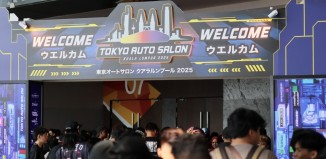Ford to Redevelop Rouge Complex
The world’s largest automobile manufacturing complex – Ford’s Rouge Centre in Michigan, USA – will be redeveloped at the cost of US$2 billion to create a world-class facility that will be the flagship of the company’s vision of sustainable manufacturing for the future. It is the largest industrial redevelopment project in the USA and will transform one of the symbols of the industrial age which has endured for 83 years.
“This new facility will be designed to expand our manufacturing vision and also test advanced environmental concepts; over time, it will become a new model for future Ford facilities,” declared James Padilla, Ford’s group vice-president for global manufacturing. Mr Padilla said that the idea of “flexible manufacturing” will be taken to a new level by designing a plant capable of interchanging three vehicle platforms and up to nine different models.
“The ability to produce different cars and trucks on the same lines will allow us much greater flexibility to respond quickly to consumer demand and changes in the market,” he explained, adding that in the long run, this capability will also allow Ford to better satisfy its customers.
LEANER MANUFACTURING PROCESSES
The flexible tooling equipment will incorporate state-of-the-art lean manufacturing principles including synchronous material flow and advanced in-station process controls. As part of its super-lean operations, the new plant will reduce by nearly 40% the number of workstations normally needed to move a vehicle through the assembly process. Also, individual operators will have greater responsibility to complete and verify operations within the workstations.
In contrast to the days when component supply had to be assured and the factory inventory was substantial, the transformed plant will have significantly less space dedicated to component as well as vehicle storage. Finished vehicle storage space will be reduced by 50% inside and outside the plant and there will be no more than two hours of parts stacked at the sides of assembly lines. Off-line inventory will be slashed to 10 hours; for many assembly plants, normal inventory supply is at least one to two days, if not more.
“That means that 90% of vehicles produced will be shipped the same day,” said Mr Padilla. To meet those demands, there will be approximately 500 inbound deliveries and 200 outbound shipments daily. The original railroad track which measures 24 kms will be removed.
A brand new paint shop which began operations in September, currently used by the Dearborn Assembly Plant, will also serve the new plant. It will have world-class, water-based primer and basecoat paint systems and a high-solids clearcoat system. Together with advanced abatement equipment, the new paint shop will feature significantly reduced emissions while maintaining high quality standards.
OPTIMISED PROCESSES
Other key features of the new plant will focus on the major Ford Production System elements of safety, quality, delivery and employee well-being. They include:
– synchronous manufacturing and just-in-time delivery of parts, achieved with drive-through truck docks that have side unload delivery capability;
– electrical monorail system and power-roll lift tables that provide greater flexibility to adjust line speeds and address quality issues quickly on the line;
– mezzanine levels and overhead walkways which will reduce pedestrian traffic in work areas and, as an added safety feature, no forklifts will be allowed in the production areas;
– a food court concept with a patio and eating area on the roof of the plant, instead of the traditional crowded and noisy canteen common to many factories; and
– 35 huge skylights that will provide natural lighting for a more pleasant work environment;
– ergonomically-designed conveyors that adjust to people, eliminating the need for people to adjust to the height of conveyors;
– conditioning of air inside the plant; during summertime, there will be less humidity and the air will be at least 15 degrees F. cooler than the air on the outside.
With the new plant will come new approaches to working such as meeting weekly in work teams, with each team having its own meeting room. Connectivity between the plant floor and suppliers will also be improved and all teams will have the ability to electronically interact with suppliers on technical and quality issues direct from PC-equipped workstations.
ADVANCED ECO-FRIENDLY CONCEPTS
While the new Ford Rouge Centre will be a highly efficient manufacturing facility of automobiles, its operations will not have a negative impact on the environment around it. In fact, Mr Padilla said that it will have advanced ecological concepts in its design and processes.
“For a manufacturing plant, that may seem like an impossible dream as there is always a conflict between economy and ecology. But we are passionate that it is a goal worth pursuing,” he said with the conviction of an evangelist.
In this respect, one of the most prominent ecological features will be the world’s largest industrial “living roof” which will cover an area of 41, 827 sq. metres. The foliage – which will also be grown on the walls – will absorb carbon dioxide and help keep the air fresher. In fact, Mr Padilla claims that when its is completed and in full operation, the new Rouge Complex will absorb more CO2 than other conventionally-designed factories, while generating less CO2. Apart from providing natural insulation against sudden changes in temperature and the harmful effects of the sun’s UV rays, this roof can absorb rainwater and provide a way of effectively managing run-off flow as a flood control measure around the site.
Adjacent to the new plant will be a large meadow which will be reserved for wildlife and hopefully attract migratory birds. Around the facility, there will be 1,500 trees planted, 10 times more than the number presently growing. Plants grown in the area will be chosen for their ability to absorb toxins, eg sunflowers, and also leach toxins from the soil. This will ensure that the Rouge River is not polluted by the factory.
The original Rouge Complex had its own powerplant which produced enough electricity not only for plant operations but also for the nearby city. In the new plant, new energy sources will be used. Fuel cells will power some of the computer systems and studies are being done to see which other renewable sources are most suitable (solar and wind power are among the possibilities).
“We began examining the complex during the 1990s and could have closed it down and just build a brand new plant elsewhere – at less cost that renovating a facility which was going to be technologically obsolete in 2000. That’s the usual approach taken in America where old unwanted assets are just shuttered or disposed of,” Mr Padilla told AUTOWORLD.COM.MY’s Chips Yap.
“But Ford decided that it would not abandon its homebase and its history, so we are doing a “brownfield” project and will show that it is indeed possible to renew this icon of manufacturing and proudly bring it into the 21st century,” he said. “The initiatives we take in developing the new Ford Rouge Complex will be applied to our other plants around the world. Therefore, a bright future for the Ford Rouge Centre is extremely important to us.”

























